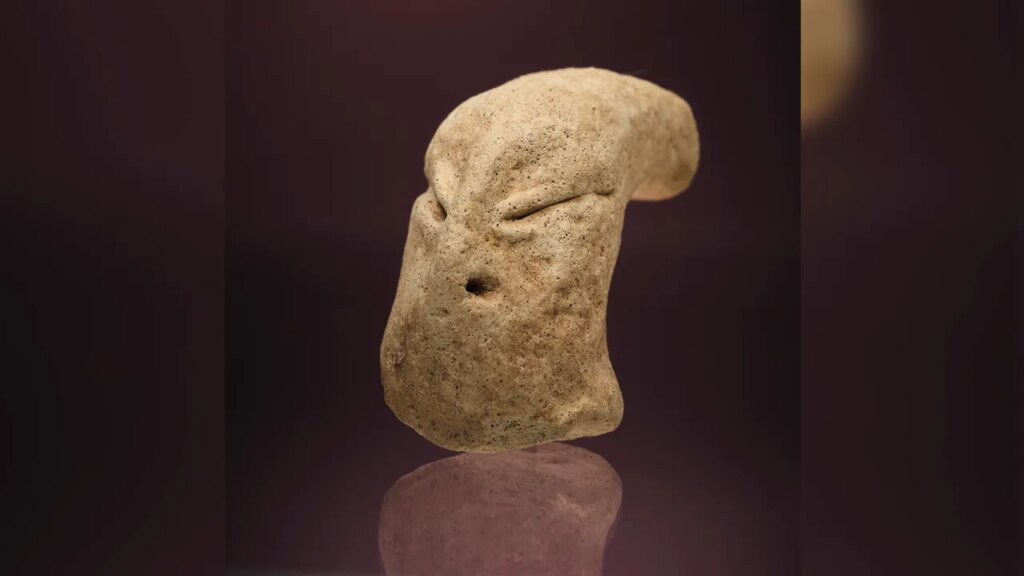In an intriguing archaeological development, a peculiar artifact resembling an alien-like clay head has been unearthed in Kuwait, igniting curiosity among researchers and the broader archaeological community. This discovery was made by the Kuwaiti-Polish Archaeological Mission at the Bahra 1 site, which is located in the Subiya region of Kuwait. The news was primarily reported in a press release issued by the University of Warsaw on November 28, emphasizing the artifact’s distinctive features and significant historical implications.
The clay head, described as a “small, finely crafted clay head featuring an elongated skull, slanting eyes, and a flat nose,” dates back to the Ubaid period of ancient Mesopotamia, estimated to have occurred during the 6th millennium BCE. This positions the artifact between 7,000 and 8,000 years old. While similar figurines from the Ubaid culture have been discovered in other regions, this particular piece stands out as the first of its kind found in the Persian Gulf, raising questions concerning its intended purpose and its symbolic or ritualistic value to the ancient community that created it.
Professor Piotr Bieliński, a notable figure from the excavation team, remarked on the significance of the artifact’s presence at the site, emphasizing its potential connections to the social or religious structures of the time. Such findings are essential for understanding the cultural and historical context of the Ubaid civilization, which is regarded as a forerunner of later Mesopotamian societies.
The Bahra 1 excavation site has also yielded two distinct pottery types, further underscoring its archaeological importance. The University of Warsaw highlighted that the excavations uncovered Ubaid pottery known to be imported from Mesopotamia, alongside a local variation referred to as Coarse Red Ware (CRW). Until this discovery, the precise origins of Coarse Red Ware had been largely speculative, but the finding of an unfired clay vessel at Bahra 1 provided the first concrete evidence of its local production in the Gulf region.
Moreover, the discovery at the site casts Bahra 1 as one of the oldest and largest known settlements in the Arabian Peninsula, and notably, as the oldest-known pottery production site in the Persian Gulf. The presence of small plant fragments mixed with clay during the pot-making process reflects the utilization of local resources and provides further context regarding the region’s flora during the period. Dr. Roman Hovsepyan, another key researcher involved in the project, indicated that preliminary analyses signal the use of wild plants, with notable mentions of reeds, while cultivated crops such as barley and wheat have been identified in the imported Ubaid pottery.
Looking forward, the Kuwaiti-Polish Archaeological Mission is committed to furthering its studies at Bahra 1 to yield additional discoveries. These efforts are aligned not only with unearthing more artifacts but also with enhancing collaboration between Polish and Kuwaiti heritage specialists. The current excavations are pivotal in deepening the understanding of the interactions between Arabian Neolithic societies and the Ubaid cultures that traversed from Mesopotamia reaching far into regions such as Anatolia and the Arabian Peninsula.
As research progresses, the unique findings from Bahra 1 continue to enrich our understanding of ancient cultural exchanges and interactions that shaped early civilizations. These discoveries highlight the fragility and richness of archaeological heritage in the region and underscore the importance of international cooperation in preserving and understanding our shared human history.
For more commentary and insights pertaining to lifestyle topics and archaeological developments, readers can explore further articles on Fox News Digital and Fox Business. This exploration into the past not only unveils forgotten stories but also connects present generations with the intricate tapestry of human civilization’s development.



